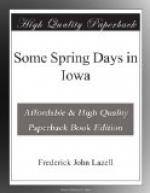It is worth while on a walk in June to sit and look at the grass. How tame and dreary would be the landscape without it! How soul starved would have been mankind, condemned to live without the restfulness of its unobtrusive beauty! That is why the first command, after the waters had been gathered into one place and the dry land appeared, was, “Let the earth bring forth grass.” The grasses cover the earth like a beautiful garment from Kerguelen land in the Antarctic regions to the extreme limit of vegetation beyond the Polar circle. They climb the Andes, the Rockies, and the Himalayas to the very line of eternal snow, and they creep to the bottom of every valley where man dares set his foot. They come up fresh and green from the melting snows of earliest spring and linger in sunny autumn glens when all else is dead and drear. They give intense interest to the botanist as he remembers that there are thirty-five hundred different species, a thousand of which are in North America and a fourth of that number in our own state. They give him delightful studies as he patiently compares their infinite variations of culms and glumes, spikes, racemes, and panicles. They give joy to the farmer with their wealth of protein and fat and albuminoid, the material to do the work and make the wealth of the world bulging from their succulent stems. And they are fascinating most of all to the nature-lover as he sees them gently wave in the June sunshine or flow like a swift river across the field before a quick gust of wind. Such variety of color! Here an emerald streak and there a soft blue shadow, yonder a matchless olive green, and still farther a cool gray: spreading like an enamel over the hillside where the cattle have cropped them, and waving tall and fine above the crimsoning blossoms of the clover; glittering with countless gems in the morning dews and musicful with the happy songs and call notes of the quail and prairie chicken, the meadow lark, the bob-o-link, and the dickcissel whose young are safe among the protection of the myriad stems. Tall wild rice and wild rye grow on the flood-plain and by the streams where the tall buttercups shine like bits of gold and the blackbirds have their home; bushy blue stem on the prairies and in the open woods where the golden squaw weed and the wild geranium make charming patterns of yellow and pink and purple and some of the painted cup left over from May still glows like spots of scarlet rain; tall grama grass on the dry prairies and gravelly knolls, whitened by the small spurge and yellowed by the creeping cinquefoil; nodding fescue in the sterile soils where the robin’s plantain and the sheep sorrel have succeeded the early everlasting; satin grasses in the moist soil of the open woodlands where the fine white flowers of the Canada anemone blow, and slough grass in the marshy meadows where the white-crossed flowers of the sharp spring are fading, and the woolly stem of the bitter boneset is lengthening; reed grass and floating manna




